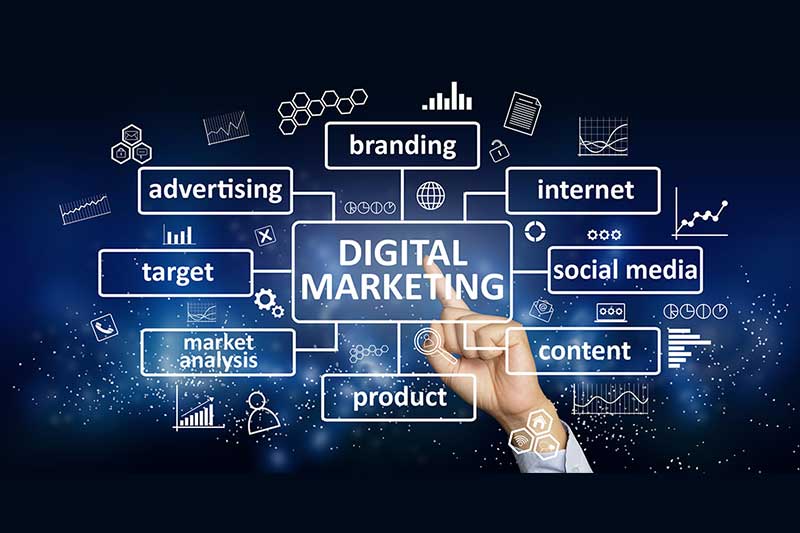What Are the Categories of Digital Marketing? Digital marketing is a marketing strategy that utilises the internet and digital devices such as computers, mobile phones, and other online platforms to promote products or services. Essentially, it is a way to reach potential customers wherever they spend time online.
Digital marketing is a broad umbrella that encompasses various strategies and techniques for marketing using digital devices and the internet. Fundamentally, digital marketing is divided into five categories. Each category, along with its explanation, can be found below! It is clear that we will be using more terms that you may not be familiar with later on. However, fundamentally, this explanation will help you understand what digital marketing is.
What Are the Categories of Digital Marketing?
Benefits of Digital Marketing for Businesses
Digital marketing offers many advantages for businesses in the modern era:
- Wider Reach: Businesses can reach audiences globally without geographical limitations.
- Precise Targeting: Advertisements and content can be targeted to the most relevant audience segments, enhancing campaign effectiveness.
- More Cost-Efficient: Often cheaper compared to traditional marketing methods with the potential for greater results.
- Measurement and Data Analysis: Campaign performance data can be analysed in real-time for ongoing optimisation.
- Enhancing Brand Awareness and Reputation: A strong online presence helps build and strengthen brand image.
- Customer Interaction: Enables direct communication and fosters a loyal community.
- Flexibility and Rapid Adaptation: Strategies can be quickly adjusted to keep up with trends or market changes.
Although it can be divided into many specific types, the main categories can be grouped as follows:
1. Search Engine Marketing (SEM)
This category focuses on enhancing the visibility of your business in search engine results such as Google. It is divided into two main subcategories:
- Search Engine Optimisation (SEO): This is a strategy for improving your website’s ranking organically (non-paid) in search results. This is achieved by optimising website content, technical structure, and building backlinks so that search engines consider your website relevant and authoritative for specific keywords. The primary aim is to obtain free traffic from search results.
- Pay-Per-Click (PPC) Advertising: This is a paid strategy where you pay each time your ad is clicked. The most common example is Google Ads, where your ads appear at the top or bottom of search results with the label “Ads”. This allows you to gain instant visibility for specific keywords.
2. Content Marketing
This category focuses on the creation and distribution of valuable, relevant, and consistent content to attract, engage, and retain an audience. The aim is not to sell directly, but to build trust and brand authority, as well as educate the audience. The forms of content can vary:
- Blog Articles: Informative or educational writings published on your website’s blog.
- Videos: Visual content that can include tutorials, product reviews, brand stories, or entertainment (YouTube, TikTok, Instagram Reels).
- Infographics: Visual representations of complex data or information in an easily understandable format.
- E-book/Whitepaper: More in-depth content, usually in PDF format, offered as a lead magnet.
- Podcasts: Audio content discussing topics relevant to the audience.
3. Social Media Marketing (SMM)
This category utilises social media platforms (such as Facebook, Instagram, Twitter/X, LinkedIn, TikTok, YouTube) to build brand awareness, engage with customers, drive traffic, and even sell products. SMM can be further divided into:
- Organic: Building followers, creating regular posts, and engaging with the audience naturally without paid advertising.
- Paid (Social Media Ads): Running paid advertising campaigns on social media platforms to target a very specific audience based on demographics, interests, behaviours, etc.
4. Email Marketing
This is one of the oldest forms of digital marketing, yet it remains highly effective. This category involves sending emails directly to potential customers or existing clients. The objectives can vary:
- Sending newsletters with the latest information or offers.
- Promoting new products or services.
- Building relationships and customer loyalty.
- Encouraging repeat purchases or conversions.
5. Affiliate and Influencer Marketing
This category involves collaboration with third parties to promote your products or services.
- Affiliate Marketing: You pay a commission to individuals or companies (affiliates) who successfully direct sales or leads to your business through their unique links or codes.
- Influencer Marketing: You collaborate with individuals who have a large and loyal following on social media or other platforms (influencers) to promote your products or services.
What Are the Categories of Digital Marketing?
Hope it is useful 🙂

